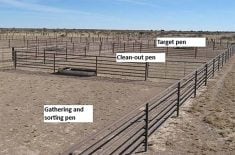HUMBOLDT, Sask. – Cecil Stumborg wanted a piece of land where he could build a house, set down roots and escape the hustle and bustle of Humboldt, Sask.
Today, he and his wife, Jane Stumborg, are co-owners of Wolverine Bison Company, with partners Mark and Denise Silzer, grain farmers from Lake Lenore, Sask.
The company has expanded its land base to four quarter sections and now has a breeding herd of about 130 bison cows.
With calves, backgrounders, finishers and breeding bulls included, the number of bison roaming the fields outside Stumborg’s home can reach as high as 400 depending on the time of year.
Read Also

University of Saskatchewan experts helping ‘herders’ in Mongolia
The Canadian government and the University of Saskatchewan are part of a $10 million project trying to help Mongolian farmers modernize their practices.
“I like animals and we were just looking for something to get into,” said Stumborg.
“I didn’t think we were going to grow (the operation) this much but it just kind of happened that way.”
Getting into the bison industry has been a learning experience for Stumborg.
Bison meat markets were not well developed at first and yearling heifers were fetching $4,000 to $5,000 per head.
“It was pretty tough through those years but we got in and I guess we were fortunate in that the bison operation in the early years wasn’t something that either of us had to extract a living out of,” said Mark Silzer. “It was set up as sort of a side business.”
Stumborg and Silzer have learned a lot about production. They’ve expanded their herd and the bison industry has matured to the point where demand for bison meat is strong and the business is profitable.
Wolverine’s bison are frequent winners at western Canadian bison shows and the company’s breeding animals have developed a reputation. Stumborg said much of the success is because the company started with good genetics and kept close records of their animals’ growth rates and production histories.
“We made some mistakes too,” said Stumborg. “When we got in, some of the animals we bought weren’t that great either but we learned a lot just by our own doing.”
Silzer agreed that the company’s focus on genetics and sound management has helped to establish the company’s reputation.
“We know what the cows are actually producing and we track (the calves’) weights right through until finish and even after if they go out into the breeding herd, and based on those records, we cull pretty extensively so we just continue to improve and build the herd, based on those records,” said Silzer.
Both Stumborg and Silzer agree that the bison industry has turned the corner after numerous setbacks.
The 2001 terrorist attacks in New York and Washington, D.C., took a toll on the U.S. restaurant industry, a major consumer of bison meat produced in North America.
In 2004, the discovery of BSE in a Canadian cattle herd closed the U.S. market to all Canadian bison products, leaving producers without access to their primary export market.
“Some of our producers just couldn’t weather that storm. They had bought animals at high prices and now, markets were really depressed and the U.S. market was shut off so it had a pretty major impact on finished prices,” said Silzer.
Today, demand for bison meat in Canada, the United States and Europe continues to grow and supplies are limited.
“Right now, we’re completely reversed and on the other side of this cycle,” said Silzer, who serves as president of the Canadian Bison Association.
“We’re looking at really, really tight supplies of market ready bison and as bison prices continue to improve, we’ve got new people looking to get into the industry and other people looking to expand.”
Stumborg said meat is selling and markets are stable.
“You’re not getting the big dollars that you were in the 1990s for breeding stock but it’s more realistic.”















